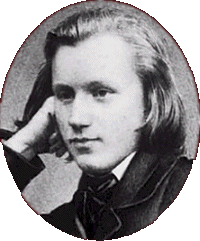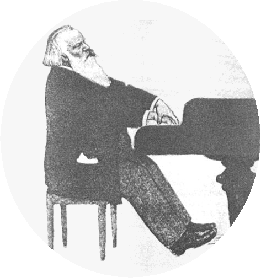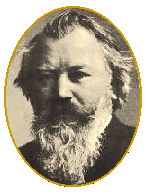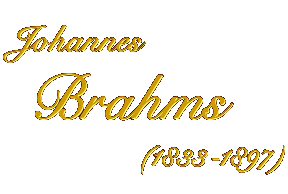
For a time, Brahms also learned the cello, although his progress was cut short when his teacher absconded with Brahms's instrument. His piano teachers were first Otto Cossel and then Eduard Marxsen, who had studied in Vienna with Ignaz Seyfried (a pupil of Mozart) and Carl von Bocklet (a close friend of Schubert). The young Brahms gave a few public concerts in Hamburg, and though he did not become well known as a pianist he made some concert tours in the 1850s and 60s and in later life frequently participated in the performance of his own works, whether as soloist, accompanist, or participant in chamber music. Notably he gave the premieres of both his Piano Concerto No. 1 in 1859 and his Piano Concerto No. 2 in 1881. In his early teens he began to conduct choirs and eventually became an efficient choral and orchestral conductor.
He began to compose quite early in life (we know of a piano sonata he played or improvised at the age of 11), but his efforts did not receive much attention until he went on a concert tour as accompanist to the Hungarian violinist Eduard Reményi in April-May 1853. On this tour he met Joseph Joachim at Hanover, and went on to the Court of Weimar where he met Franz Liszt, Cornelius and Raff. According to several witnesses of Brahms's meeting with Liszt, at which Liszt performed Brahms's own op.4 Scherzo at sight, Reményi was offended by Brahms' failure to praise Liszt's Sonata in B minor wholeheartedly (Brahms fell asleep during a performance of the recently-composed work), and they shortly afterwards parted company, although it was not clear as to whether Liszt felt offended or otherwise.
Joachim had given Brahms a letter of introduction to Robert Schumann, however, and Brahms walked to Düsseldorf, arriving on 30 September and being
 welcomed into the Schumann family. Schumann, amazed by the 20-year-old's talent, published an article 'Neue Bahnen' (New Paths) in the journal
Neue Zeitschrift fur Musik alerting the public to the young man whom he claimed was 'destined to give ideal expression to the times'.
This pronouncement was received with some scepticism outside Schumann's immediate circle, and may have increased the naturally self-critical
Brahms's need to perfect his works and technique. While he was in Düsseldorf Brahms participated with Schumann and Albert Dietrich in writing
the jointly-composed 'F-A-E' Sonata for Joachim. He became very attached to Schumann's wife, the composer and pianist Clara, 14 years his senior,
with whom he would carry on a lifelong, emotionally passionate, but perhaps only platonic, relationship. Brahms never married, despite strong feelings
for several women and despite entering into an engagement, soon broken off, with Agathe von Siebold in Göttingen in 1859. After Schumann's attempted
suicide and subsequent incarceration in a mental sanatorium near Bonn in February 1854, Brahms was the main go-between between Clara and her husband,
and found himself virtually head of the household.
welcomed into the Schumann family. Schumann, amazed by the 20-year-old's talent, published an article 'Neue Bahnen' (New Paths) in the journal
Neue Zeitschrift fur Musik alerting the public to the young man whom he claimed was 'destined to give ideal expression to the times'.
This pronouncement was received with some scepticism outside Schumann's immediate circle, and may have increased the naturally self-critical
Brahms's need to perfect his works and technique. While he was in Düsseldorf Brahms participated with Schumann and Albert Dietrich in writing
the jointly-composed 'F-A-E' Sonata for Joachim. He became very attached to Schumann's wife, the composer and pianist Clara, 14 years his senior,
with whom he would carry on a lifelong, emotionally passionate, but perhaps only platonic, relationship. Brahms never married, despite strong feelings
for several women and despite entering into an engagement, soon broken off, with Agathe von Siebold in Göttingen in 1859. After Schumann's attempted
suicide and subsequent incarceration in a mental sanatorium near Bonn in February 1854, Brahms was the main go-between between Clara and her husband,
and found himself virtually head of the household.
After Schumann’s death at the sanatorium in 1856 Brahms divided his time between Hamburg, where he formed and conducted a ladies’ choir, and the principality of Detmold, where he was court music-teacher and conductor. He first visited Vienna in 1862, staying there over the winter, and in 1863 was appointed conductor of the Vienna Singakademie. Though he resigned the position the following year he based himself increasingly in Vienna and soon made his home there, though he toyed with the idea of taking up conducting posts elsewhere. From 1872 to 1875 he was Director of the concerts of the Vienna Gesellschaft der Musikfreunde; afterwards he accepted no formal position. He refused an Honorary Doctorate of Music from University of Cambridge in 1877 (he was afraid of being lionized in England, where his music was already very popular) but accepted one from the University of Breslau in 1879, composing the Academic Festival Overture in response.
 He had been composing steadily throughout the 1850s and 60s, but his music had evoked divided critical responses and the First Piano Concerto had been
badly received in some of its early performances. His works were labelled old-fashioned by the 'New German School' whose principal figures included
Liszt and Wagner. Brahms in fact admired some of Wagner's music and admired Liszt as a great pianist, but in 1860 he attempted to organize a public
protest against some of the wilder excesses of their music. His manifesto, which was published prematurely with only three supporting signatures,
was a ludicrous failure and he never engaged in public polemics again. It was the premiere of Ein deutsches Requiem, his largest choral work,
in Bremen in 1868 that confirmed Brahms's European reputation and led many to accept that he had fulfilled Schumann’s prophecy.
This may have given him the confidence finally to complete a number of works that had been wrestled with over many years, such as the cantata Rinaldo,
his first String Quartet, Third Piano Quartet and, most notably, his First Symphony; this appeared in 1876, though it had been begun
(and a version of the first movement seen by some of his friends) in the early 1860s. The other three symphonies then followed in fairly rapid succession
(1877, 1883, 1885). From 1881 he was able to try out his new orchestral works with the court orchestra of the Duke of Meiningen, whose conductor was
Hans von Bulow.
He had been composing steadily throughout the 1850s and 60s, but his music had evoked divided critical responses and the First Piano Concerto had been
badly received in some of its early performances. His works were labelled old-fashioned by the 'New German School' whose principal figures included
Liszt and Wagner. Brahms in fact admired some of Wagner's music and admired Liszt as a great pianist, but in 1860 he attempted to organize a public
protest against some of the wilder excesses of their music. His manifesto, which was published prematurely with only three supporting signatures,
was a ludicrous failure and he never engaged in public polemics again. It was the premiere of Ein deutsches Requiem, his largest choral work,
in Bremen in 1868 that confirmed Brahms's European reputation and led many to accept that he had fulfilled Schumann’s prophecy.
This may have given him the confidence finally to complete a number of works that had been wrestled with over many years, such as the cantata Rinaldo,
his first String Quartet, Third Piano Quartet and, most notably, his First Symphony; this appeared in 1876, though it had been begun
(and a version of the first movement seen by some of his friends) in the early 1860s. The other three symphonies then followed in fairly rapid succession
(1877, 1883, 1885). From 1881 he was able to try out his new orchestral works with the court orchestra of the Duke of Meiningen, whose conductor was
Hans von Bulow.
Brahms frequently traveled, both for business (concert tours) and pleasure. From 1878 onwards he often visited Italy in the springtime, and usually sought out a pleasant rural location in which to compose during the summer. He was a great walker and especially enjoyed spending time in the open air, where he felt that he could think more clearly.
In 1890, the 57-year-old Brahms resolved to give up composing. However, as it turned out, he was unable to abide by his decision, and in the years before his death he produced a number of acknowledged masterpieces. His admiration for Richard Muhlfeld, clarinettist with the Meiningen orchestra, caused him to compose the clarinet quintet Op.115 (1891), clarinet trio Op.114 (1891) and the two clarinet sonatas Op. 120 (1894). He also wrote several cycles of piano pieces, Opp.116-119 and the Four Serious Songs (Vier ernste Gesänge) Op. 121 (1896).
 While completing the Op. 121 songs Brahms fell ill of cancer (sources differ on whether this was of the liver or pancreas). His condition gradually
worsened and he died on April 3, 1897. Brahms is buried in the Zentralfriedhof in Vienna.
While completing the Op. 121 songs Brahms fell ill of cancer (sources differ on whether this was of the liver or pancreas). His condition gradually
worsened and he died on April 3, 1897. Brahms is buried in the Zentralfriedhof in Vienna.
Although Brahms may be often regarded as one of the last bastions of the Romantic Period, he was not a mainstream Romantic but rather maintained a Classical sense of form and logic within his works in contrast to the opulence and excesses of many of his contemporaries. Thus many admirers--though not necessarily Brahms himself---saw him as the champion of traditional forms and "pure music," as opposed to the New German embrace of program music. Alongside Anton Bruckner, Brahms was perhaps the major practitioner of the symphony during the latter half of the 19th century; his symphonies helped revive a virtually moribund genre and pave the way for others such as Gustav Mahler and Jean Sibelius. Though he was viewed as diametrically opposed to Wagner during his lifetime, it is incorrect to characterize Brahms as a reactionary. His point of view looked both backward and forward; his output was often bold in harmony and expression, prompting Arnold Schoenberg to write his important essay entitled "Brahms the Progressive" which paved the way for the revaluation of Brahms's reputation in the 20th century. Only in recent decades have scholars begun to examine Brahms's remarkably original rhythmic conceptions, which include 5- and 7-beat meters.
It is (perhaps) significant that Brahms himself had considered giving up composition at a time when all notions of tonality were being stretched to their limit and that further expansion would seemingly only result in the rules of tonality being broken altogether. It should be noted, however, that he offered substantial encouragement to Schoenberg's teacher Alexander Zemlinsky and was apparently much impressed by an early quartet of Schoenberg's.
Works
 Brahms wrote a number of major works for orchestra, including four symphonies, two piano concertos (See First Piano Concerto; Second Piano Concerto),
a Violin Concerto, a Double Concerto for violin and cello, and the large choral work A German Requiem (Ein deutsches Requiem). The last is notable in
not being a traditional, liturgical requiem (Missa pro defunctis), but a setting of texts which Brahms selected from the Luther Bible. Brahms was also
a prolific composer in the theme and variation form, having notably composed the Variations and Fugue on a Theme by Handel, Paganini Variations,
and Variations on a Theme by Joseph Haydn, along with other lesser known sets of variations.
Brahms wrote a number of major works for orchestra, including four symphonies, two piano concertos (See First Piano Concerto; Second Piano Concerto),
a Violin Concerto, a Double Concerto for violin and cello, and the large choral work A German Requiem (Ein deutsches Requiem). The last is notable in
not being a traditional, liturgical requiem (Missa pro defunctis), but a setting of texts which Brahms selected from the Luther Bible. Brahms was also
a prolific composer in the theme and variation form, having notably composed the Variations and Fugue on a Theme by Handel, Paganini Variations,
and Variations on a Theme by Joseph Haydn, along with other lesser known sets of variations.
Brahms also wrote a great deal of work for small forces. His many works of chamber music form part of the core of this repertoire, as does his solo piano music. Brahms is also considered to be among the greatest of composers of lieder, of which he wrote about 200. He also wrote a set of chorale preludes for organ shortly before his death, which have become an important part of the standard organ repertoire.
Brahms never wrote an opera, nor did he ever write in the characteristic 19th century form of the tone poem. Brahms strongly believed in absolute music, that is, music that does not rely upon a concrete scene or narrative as the tone poem does.
Despite his (deserved) reputation as a composer of great seriousness and of large, complex musical designs, in his lifetime some of Brahms's most widely-known and commercially successful compositions were small-scale and popular in intention, aimed at the then-large market of domestic music-making. These included his Hungarian Dances, the Waltzes op.39 for piano duet, the Liebeslieder Waltzes for vocal quartet and piano, and some of his many songs, notably the Wiegenlied, op.49 no.4 (published in 1868). This last item was written (to a folk text) to celebrate the birth of a son to Brahms's friend Bertha Faber, and is known throughout the English-speaking world as 'Brahms's Lullaby'.
Influences on Brahms
Brahms venerated Beethoven, perhaps even more than the other Romantic composers did. In the composer's home, a marble bust of Beethoven looked down on the spot where he composed. His works contain a number of apparent imitations of Beethoven. Thus, the beginning of Brahms's First Piano Sonata is very close to the opening of Beethoven's Hammerklavier sonata; and the main theme of the finale of Brahms's First Symphony is reminiscent of the main theme of the finale of Beethoven's Ninth. (When the latter resemblance was pointed out to Brahms, he replied, "Any ass can see that.") His work A German Requiem was largely inspired by his mother's death in 1865, but also incorporates material from the Symphony he had started in 1854
but later abandoned following Schumann's suicide attempt. He once wrote that the Requiem 'belonged to Schumann'. (The first movement of this abandoned
Symphony was re-worked as the first movement of the First Piano Concerto).
His work A German Requiem was largely inspired by his mother's death in 1865, but also incorporates material from the Symphony he had started in 1854
but later abandoned following Schumann's suicide attempt. He once wrote that the Requiem 'belonged to Schumann'. (The first movement of this abandoned
Symphony was re-worked as the first movement of the First Piano Concerto).
Brahms also loved the earlier Classical composers Mozart and Haydn. He collected first editions and autographs of their works, and also edited performing editions. Even more remarkable than this was his deep learning and study of the pre-classical composers including Bach, Giovanni Gabrieli, Hasse, Schütz and others. He was the friend of many of the leading musicologists of his day and himself edited works by Rameau and Carl Philipp Emanuel Bach. He was well ahead of his time in his creative interest in this 'Early Music' as composer, performer and scholar and particularly looked to such older music for inspiration in the arts of strict counterpoint.
Brahms's affection for the Classical period may also be reflected in his choice of genres: he favored the Classical forms of the sonata, symphony, and concerto, and frequently composed movements in sonata form. Although Brahms is often labeled as the most "Classical" Romantic composer, this label does not reflect his works. It was his public divide between the musical schools of Richard Wagner and himself that gained him this label, as he often criticized Wagner's "lack of counterpoint" in his compositions. If one closely examines the work of Brahms, they will notice that he is fully Romantic in style, blurring the lines of compositional form as much as any other composer was doing at the time. The rivalry between Brahms and Wagner, however, left a large divide in the musical community, those who were on the side of Brahms, and those who favored Wagner's music. Although Wagner was a fierce rival of Brahms, later in his life, Brahms admitted how much he respected Wagner's compositions.
A quite different influence on Brahms was folk music. Brahms wrote settings for piano and voice of 144 German folk songs, and many of his lieder reflect folk themes or depict scenes of rural life. His Hungarian dances were among his most profitable compositions, and in orchestrated versions remain well known today.
Brahms was almost certainly influenced by the technological development of the piano, which reached essentially its modern form during his lifetime. Much of Brahms's piano music and many of his lieder make use of the deep bass notes and the pedal to obtain a very rich and powerful sound.
Brahms's personality
Like Beethoven, Brahms was fond of nature and often went walking in the woods around Vienna. He often brought penny candy with him to hand out to children. To adults Brahms was often brusque and sarcastic, and he sometimes alienated other people. His pupil Gustav Jenner wrote, "Brahms has acquired, not without reason, the reputation for being a grump, even though few could also be as lovable as he." He also had predictable habits which were noted by the Viennese press such as his daily visit to his favourite 'Red Hedgehog' tavern in Vienna and the press also particularly took into account his style of walking with his hands firmly behind his back complete with a caricature of him in this pose walking alongside a red hedgehog. Those who remained his friends were very loyal to him, however, and he reciprocated in return with equal loyalty and generosity. He was a lifelong friend with Johann Strauss II though they were very different as composers. Brahms even struggled to get to the Theater an der Wien in Vienna for Strauss' premiere of the operetta Die Göttin der Vernunft in 1897 before his death. Perhaps the greatest tribute that Brahms could pay to Strauss was his remark that he would have given anything to have written The Blue Danube waltz. An anecdote dating around the time Brahms became acquainted with Strauss is that the former cheekily inscribed the words 'alas, not by Brahms!' on a fan decorated with the theme of the famous 'Blue Danube' waltz.Starting in the 1860s, when his works sold widely, Brahms was financially quite successful. He preferred a modest life style, however, living in a simple three-room apartment with a housekeeper. He gave away much of his money to relatives, and also anonymously helped support a number of young musicians.
Brahms was an extreme perfectionist. We know he destroyed many early works, including a Violin Sonata he performed with Reményi and the great violinist Ferdinand David. He claimed once to have destroyed 20 string quartets before he issued his official First in 1873. The First Piano Concerto was evolved over several years out of an original project for a Symphony in D minor, and the official First Symphony was toiled over from about 1861 to 1876. Even after its first few performances, Brahms destroyed the original slow movement and substituted another before the score was published. (A conjectural restoration of the original slow movement has been published by Robert Pascall.) Another factor that contributed to Brahms's perfectionism was that Schumann had announced early on that Brahms was to become the next great composer like Beethoven, a prediction that Brahms was determined to live up to. This prediction hardly added to the composer's self-confidence, and may also have contributed to the delay in producing the First Symphony. However, Clara Schumann noted before that Brahms' First Symphony was a product that was not reflective of Brahms' real nature as she felt that the final exuberant movement was 'too brilliant' as she was encouraged by the dark and tempestuous opening movement when Brahms first sent to her the initial draft. However, she recanted in accepting the Second Symphony, which has often been seen in modern times as one of his sunniest works. Other contemporaries, however, found the first movement especially dark, and Reinhold Brinkmann, in a study of Symphony No.2 in relation to 19th-century ideas of melancholy, has published a revealing letter from Brahms to the composer and conductor Vinzenz Lachner in which Brahms confesses to the melancholic side of his nature and comments on specific features of the movement that reflect this.
As for Brahms's place in musical history, which so concerned him, he would no doubt be gratified in knowing that posterity has indeed placed him among
the three great "Bs" of German composers — Bach, Beethoven and Brahms.

With lots of help from Wikipedia, the free encyclopedia

